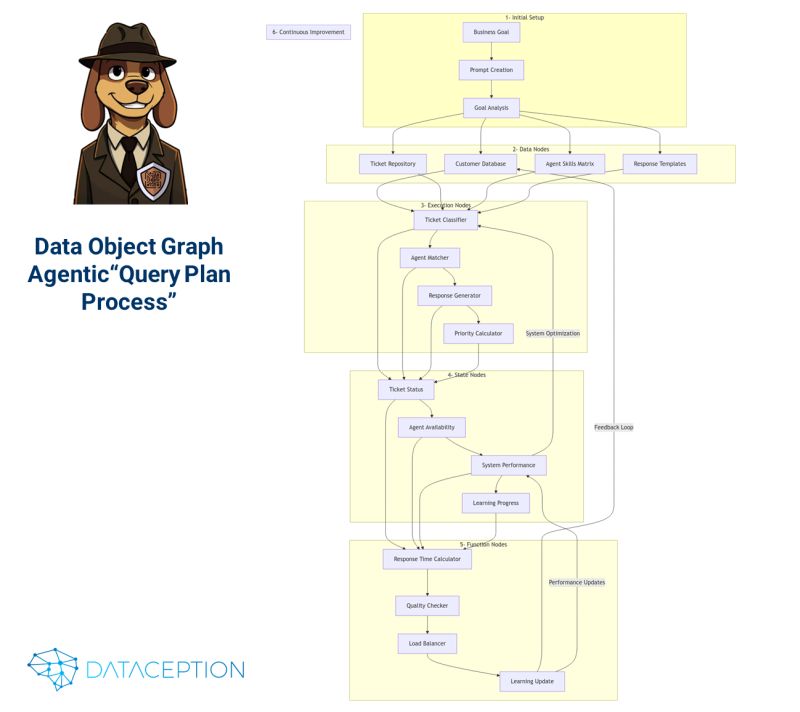A common question we get asked is: How do we ensure predictability and transparency in AI-driven, agentic workflows?
Traditional AI agents often operate within opaque, sequential memory buffers and LLM-generated decision paths, making it difficult to track execution states and understand their reasoning.
But when agents leverage Data Object Graphs (DOGs), they gain structured, queryable memory architectures that dynamically map and record relationships between data and execution nodes (data products). This means transparent state tracking and real-time visibility across multiple interactions.
🔎 How DOGs Enhance AI Workflow Transparency
Let’s take a business objective and show how an AI-powered DOG system would map and execute it in a structured, explainable manner:
📝 Business Goal:
"Reduce customer support response time by 50%"
🐕 How the DOG Handles It
📌 Step 1: Goal Analysis & Prompt Engineering
- Breaks down high-level objectives into measurable, trackable components
- Generates specific, actionable prompts to guide AI decision-making
- Establishes clear KPIs and success metrics
📍 Step 2: DOG Runner Architecture
The AI constructs a Data Object Graph, incorporating:
🔹 Data Nodes: Customer databases, ticket repositories, agent skill matrices
🔹 Execution Nodes: Ticket classifiers, agent matchers, response generators
🔹 State Nodes: Real-time system status, agent availability, performance tracking
🔹 Function Nodes: Quality checks, load balancers, learning update mechanisms
📈 Step 3: Real-World AI Support System Example
💡 Input: "Create an AI-enhanced support system with sub-1-hour response times"
🚀 Generated Data Object Graph (DOG):
🔹 Intake Phase:
- Smart ticket reception & classification
- Priority assessment based on multiple factors
- AI-generated initial response
🔹 Processing Phase:
- AI-powered agent matching
- Response suggestion system
- Resource optimization for response efficiency
🔹 Execution & Feedback Phase:
- Response delivery optimization
- Quality assurance mechanisms
- Performance tracking and analysis
- Continuous learning and self-optimization
📊 Results & Business Impact
✅ Response times reduced by over 50%
✅ Customer satisfaction increased by 35%
✅ Agent efficiency improved by 40%
✅ System self-optimizes through continuous learning
🔑 Key Takeaways: How DOGs Enable AI Transformation
1️⃣ AI systems using DOGs create self-improving workflows
2️⃣ Every AI component directly ties to business objectives
3️⃣ Built-in feedback loops drive continuous optimization
4️⃣ Clear success metrics ensure measurable improvements
5️⃣ Business alignment maintains focus on ROI
🚀 Why This Matters for Business Operations
By leveraging AI-powered Data Object Graphs, businesses can:
✅ Enhance decision-making with real-time visibility
✅ Optimize resource allocation dynamically
✅ Scale complex AI workflows transparently
✅ Improve operational efficiency and ROI
This is the next evolution in AI-driven business process execution, shifting from black-box AI to structured, explainable intelligence.

Would love to hear your thoughts on this! How do you see AI Agents & DOGs shaping the future of business operations? Reach out to us so we can discuss how to help you.
With Dataception's DOGs, AI is just a walk in the park! 🚀🐕

